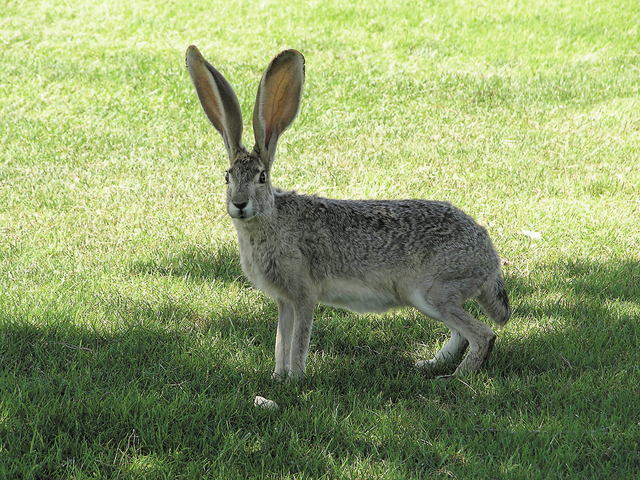Rabbit-proof fences protect gardens, landscapes
As I promised, here is an abbreviated version of the problem and solutions to rabbit vandalism in residential landscapes.
We have two types of wild rabbits in Nevada: the jackrabbit and the desert cottontail. Both of them will feed on landscape plants if they have the opportunity. Landscape plants and, consequently, their food are in abundance where there is irrigation.
I know you are aware of the huge fire that occurred just northwest of Las Vegas. This burned down prime habitat and food sources for rabbits. Guess where they will go? Where there is irrigation and food — your yard and other irrigated landscapes.
Most likely, the landscape and rabbit problem that already exists will get worse. The hardest hit areas are going to be those areas on the fringe of residential development. If you moved here not too long ago, you are now a desert dweller and have to learn how to coexist with these animals.
So, how do you prevent your landscape from becoming lunch for rabbits? You either have to exclude the animal, remove its food source or remove the problem animal.
Exclusion or keeping them out. Fences will work as long as they can’t chew through them or have holes small enough so the rabbits can’t get their heads through any opening. Once the head gets through, the rest of the animal can squeeze through as well.
Rabbits can dig. If the fence does not go below ground at least a few inches, they can dig under it and get inside. An inexpensive fence that is effective is chicken wire with hexagonal holes no larger than 1 inch that is at least 3 feet tall and buried a few inches below the surface. Do not use plastic fencing. Rabbits will chew through it. I have already tried it.
We use 1-inch hexagonal chicken wire at the University of Nevada Cooperative Extension Master Gardener Orchard in North Las Vegas to keep rabbits out of our vegetable plots. But if there is any way a rabbit can squeeze through a small opening, gap or get his nose under, it will not work.
Whenever I see damage to the vegetable plots at the orchard, I know a rabbit got in either under the fence or through some gap that needs to be repaired.
In more than 12 years, I have never seen a rabbit get access to a vegetable plot surrounded by a 3-foot tall chicken wire fence by jumping over it.
I have seen small, baby rabbits feeding on securely fenced vegetable plots in the early morning hours. My first thought was, how did they get in there? When they see me coming, they begin running at the 1-inch hexagonal chicken wire at full speed and go through the fence with barely any hesitation. However, once they get inside and begin hiding and feeding for several days, they become too large and are trapped inside.
Remove the food. Rabbits have food preferences. But like anything else, if they get hungry enough, they’ll go after food that is less desirable.
The University of Arizona Cooperative Extension has a publication on rabbit-resistant landscape plants that you can download. Visit http://extension.arizona.edu/content/javelina-deer-and-rabbit-resistant-plants.
This doesn’t mean they will not eat any of these plants. If they can get to them, are hungry enough and have little else to eat, they probably will go after them.
Remove the problem. Certainly the first two methods are preferable. The issue on what you can and cannot do to a wild animal is pretty complicated and varies depending on where you live, state and local laws and your personal conscience. Ask your local wildlife representative and check your state and local laws and regulations.
Bob Morris is a horticulture expert living in Las Vegas and professor emeritus for the University of Nevada. Visit his blog at xtremehorticulture.blogspot.com.






















